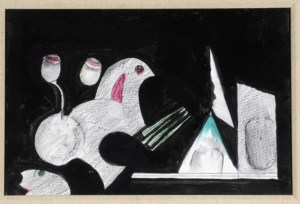Frottage was invented by Max Ernst in 1925. Find out more about how Ernst and others used this technique.
Born in Brühl in Germany in 1891 to a middle-class family Max Ernst was a German painter sculptor and graphic artist as well as a poet. Max’was inspired to take up painting by his father who was an amateur painter and had an interest in painting and sketching and nature.
Max enrolled at the University of Bonn in 1909 where he studied Philosophy, art history and literature as well as psychology and psychiatry during this time he visited asylums and developed a fascination for the art of mentally ill patients. He became an artist in 1911 and was influenced by the works of Pablo Picasso, Vincent van Gogh and Paul Gauguin.
Max Ernst’s early life was interrupted in 1914 by World War I when he was drafted and served on the Western and Eastern Front. Max was devastated by the effects of war and in his biography he wrote: “On the first of August 1914 M[ax].E[rnst]. died. He was resurrected on the eleventh of November 1918.” – Wikipedia. While on the Western front he was assigned to chart maps for a short time which allowed him to continue painting. World War I was a sad time for the expressionist movement with many of the expressionist artists dying in the trenches.
I recently watched two documentaries about the German Expressionist Movement, BBC’s ‘Art of Germany – In the Shadow of Adolph Hitler’ and ‘Degenerate Art, The Nazis vs. Expressionism’ a 1993 documentary which were both very interesting.
At the end of the war in 1918 Max returned to cologne and started the Dada movement in 1921, he is known as the pioneer of the Dada movement and surrealism.
In 1925 he invented frottage and developed it as a graphic art technique. Ernst got the idea after observing a washed-out wooden floor in his hotel in France on one rainy afternoon, which inspired him to transfer the texture of the floor to a sheet of paper using graphite. He also created textures from rubbing over objects such as textiles, bark and leaves and ‘Through precise selection, combination, control of texture and some discreet additions, he was able to build up delicate, surprising images of fantasy landscapes, plants and creatures.’ – Oxford Art Online.

The English Surrealist Maddox Conroy, (27 December 1912 – 14 January 2005) who discovered surrealism in 1935 and spent the rest of his life exploring its potential through his paintings, collages and photographs was also inspired by Max Ernst and also experimented with frottage as seen here in his Bird in the Hand (Watercolour on Paper).

Bibliography:
